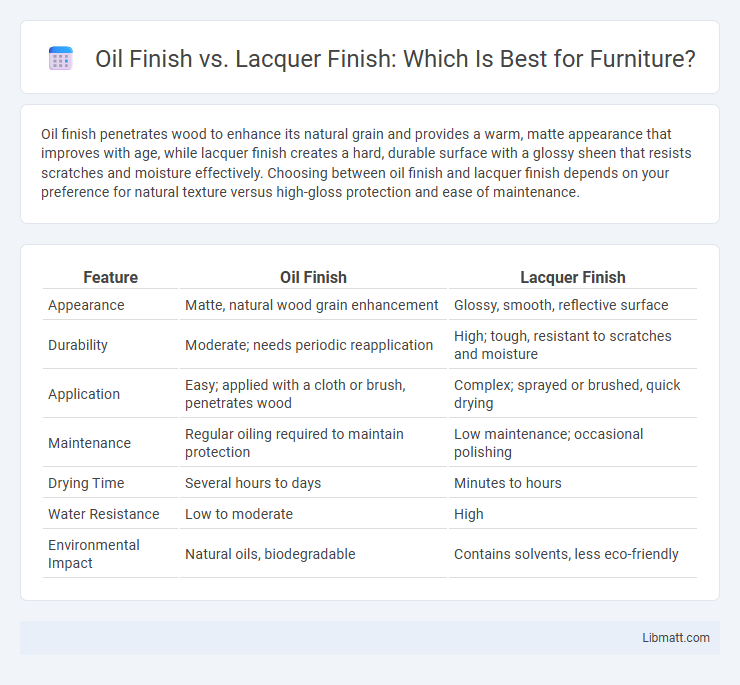Oil finish penetrates wood to enhance its natural grain and provides a warm, matte appearance that improves with age, while lacquer finish creates a hard, durable surface with a glossy sheen that resists scratches and moisture effectively. Choosing between oil finish and lacquer finish depends on your preference for natural texture versus high-gloss protection and ease of maintenance.
Table of Comparison
| Feature | Oil Finish | Lacquer Finish |
|---|---|---|
| Appearance | Matte, natural wood grain enhancement | Glossy, smooth, reflective surface |
| Durability | Moderate; needs periodic reapplication | High; tough, resistant to scratches and moisture |
| Application | Easy; applied with a cloth or brush, penetrates wood | Complex; sprayed or brushed, quick drying |
| Maintenance | Regular oiling required to maintain protection | Low maintenance; occasional polishing |
| Drying Time | Several hours to days | Minutes to hours |
| Water Resistance | Low to moderate | High |
| Environmental Impact | Natural oils, biodegradable | Contains solvents, less eco-friendly |
Introduction to Wood Finishes
Oil finish enhances wood's natural grain by penetrating deeply and providing a warm, matte appearance, while lacquer finish creates a durable, glossy surface through a quick-drying film. Oil finishes require periodic maintenance to retain protection and appearance, contrasting with lacquer's hard, protective coating that resists scratches and moisture. Choosing between oil and lacquer depends on desired aesthetics, durability, and ease of application tailored to specific woodworking projects.
What Is an Oil Finish?
An oil finish penetrates wood fibers, enhancing natural grain and providing a durable, water-resistant surface while preserving a matte to satin sheen. Common oils like tung oil and linseed oil harden upon exposure to air, creating a protective layer that requires periodic reapplication for maintenance. Unlike lacquer, oil finishes do not form a hard film on the surface but emphasize depth and texture.
What Is a Lacquer Finish?
A lacquer finish is a clear or colored coating that dries by solvent evaporation, forming a hard, durable film often used on wood and furniture surfaces. It provides a high-gloss or satin sheen, enhancing the underlying material's appearance while offering strong protection against moisture, scratches, and UV damage. Lacquer finishes dry fast and can be applied in multiple thin layers, allowing for a smooth and polished result compared to oil finishes, which penetrate the wood and offer a more natural, matte look.
Appearance and Aesthetic Differences
Oil finishes penetrate wood to enhance natural grain patterns and create a warm, matte to satin appearance that emphasizes texture and depth. Lacquer finishes form a hard, glossy surface layer that provides a smooth, reflective sheen, intensifying color vibrancy and offering a polished, uniform look. The choice between oil and lacquer significantly impacts the wood's visual character, with oil delivering a more natural, tactile feel and lacquer offering high durability with a sleek, modern aesthetic.
Durability and Protection
Oil finishes penetrate wood fibers, providing moderate durability and enhancing natural grain while offering water resistance but limited protection against scratches and heat. Lacquer finishes form a hard, protective surface layer that delivers superior durability, high resistance to abrasion, chemicals, and heat, and preserves wood from environmental damage. For long-lasting protection, lacquer finish outperforms oil, especially in high-traffic or moisture-prone environments.
Application Process Comparison
Oil finish requires multiple coats applied with a cloth or brush, penetrating wood fibers for a natural look and easy maintenance, while lacquer finish demands spray application for a smooth, durable, and glossy surface. Oil finishes take longer to cure, often needing 24 hours or more between coats, whereas lacquer dries rapidly within minutes, enabling faster project completion. The application of lacquer necessitates proper ventilation and protective equipment due to strong fumes, contrasting with the low-toxicity, user-friendly nature of oil finishes.
Maintenance and Repair
Oil finish requires regular reapplication to maintain its protective properties and easily absorbs minor scratches, allowing for simple spot repairs without sanding. Lacquer finish offers a durable, high-gloss layer resistant to moisture and stains but can be more challenging to repair, often needing professional refinishing for deep damage. Your choice depends on whether you prefer low-maintenance touch-ups or a tougher, more resilient surface that may require expert restoration.
Environmental Impact and Safety
Oil finishes are typically made from natural oils like linseed or tung, which are biodegradable and have lower volatile organic compound (VOC) emissions, making them a safer and more environmentally friendly choice for indoor air quality. Lacquer finishes often contain solvents with high VOC levels that contribute to air pollution and pose health risks such as respiratory irritation and long-term toxicity. Choosing an oil finish reduces your environmental footprint and exposure to harmful chemicals, promoting a safer workspace and home environment.
Cost and Value Considerations
Oil finish typically costs less upfront and offers a natural look with easy maintenance, making it a cost-effective option for budget-conscious projects. Lacquer finish tends to have a higher initial cost due to professional application requirements but provides a durable, high-gloss surface that can enhance long-term value. You should weigh the initial expense against desired durability and aesthetic appeal to determine which finish best fits your investment and maintenance preferences.
Choosing the Right Finish for Your Project
Oil finish enhances wood's natural grain and provides a warm, matte appearance while offering moderate protection against moisture, making it ideal for furniture and items needing a natural look. Lacquer finish forms a hard, durable, and glossy surface with superior resistance to scratches and chemicals, perfect for high-traffic or decorative pieces requiring a polished appearance. Your choice depends on balancing aesthetic preferences and durability needs to ensure the finish complements your project's function and style.
Oil Finish vs Lacquer Finish Infographic

 libmatt.com
libmatt.com